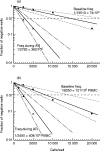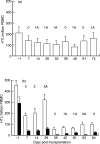T helper frequencies in peripheral blood reflect donor-directed reactivity in the graft after clinical heart transplantation
- PMID: 10594570
- PMCID: PMC1905447
- DOI: 10.1046/j.1365-2249.1999.01091.x
T helper frequencies in peripheral blood reflect donor-directed reactivity in the graft after clinical heart transplantation
Abstract
We describe the usefulness of a fast (48-h) limiting dilution assay (LDA) for the enumeration of human alloreactive helper T lymphocytes (HTL) in the peripheral blood, in relation to histologically defined rejection grades after heart transplantation. HTL frequencies (HTLf) in pretransplant samples varied from patient to patient, ranging from 106 to 625 HTL/106 peripheral blood mononuclear cells (PBMC). In the first week after heart transplantation (HTx), when immunosuppression was instituted, HTLf were significant lower (range 30-190 HTL/106). The level of HTL in the first week after HTx when rejection grade was 0 or 1A (ISHLT score) was considered to be the baseline frequency. This frequency did not correlate with the number of subsequent rejection episodes. During rejection (grade 3), donor-specific HTLf were increased above their baseline frequencies (P = 0.01). Expressed as percentage of baseline frequencies, HTLf increased significantly during acute rejection (AR) compared with 1-2 weeks before rejection (P = 0.003). The increase was specific, since viral infections did not result in a rise of donor-specific HTL, while also HTLf specific for third party HLA antigens were not elevated during rejection. Monitoring HTLf in peripheral blood with a shortened (48-h) assay may serve as a non-invasive method for detecting intragraft immunological reactivity. Demonstrating absence of donor-specific reactivity may limit the number of invasive endomyocardial biopsy (EMB) procedures and allow tapering of immunosuppressive treatment.
Figures





Similar articles
-
Increased frequency of alloantigen-reactive helper T lymphocytes is associated with human cardiac allograft rejection.Transplantation. 1993 Sep;56(3):722-7. Transplantation. 1993. PMID: 8212173
-
High frequency of IL-4 producing helper T lymphocytes associated with a reduced incidence of heart allograft rejection.Transpl Int. 2000;13 Suppl 1:S216-24. doi: 10.1007/s001470050328. Transpl Int. 2000. PMID: 11111999
-
Evidence that human cardiac allograft acceptance is associated with a decrease in donor-reactive helper T lymphocytes.Transplantation. 1995 Mar 15;59(5):778-83. doi: 10.1097/00007890-199503150-00024. Transplantation. 1995. PMID: 7886807
-
Alloreactivity and the predictive value of anti-recipient specific interleukin 2 producing helper T lymphocyte precursor frequencies for alloreactivity after bone marrow transplantation.Dan Med Bull. 2002 May;49(2):89-108. Dan Med Bull. 2002. PMID: 12064093 Review.
-
Immune monitoring in small bowel transplantation.Curr Opin Organ Transplant. 2010 Jun;15(3):349-56. doi: 10.1097/MOT.0b013e328339489c. Curr Opin Organ Transplant. 2010. PMID: 20489630 Review.
Cited by
-
Noninvasive methods to assess the risk of kidney transplant rejection.Expert Rev Clin Immunol. 2009 Sep 1;5(5):535-546. doi: 10.1586/eci.09.36. Expert Rev Clin Immunol. 2009. PMID: 20161000 Free PMC article.
-
Increased numbers of circulating donor-specific T helper lymphocytes after human heart valve transplantation.Clin Exp Immunol. 2001 Jun;124(3):353-8. doi: 10.1046/j.1365-2249.2001.01557.x. Clin Exp Immunol. 2001. PMID: 11472394 Free PMC article.
References
-
- Sharrock CEM, Kaminski E, Man S. Limiting dilution analysis of human T cells: a useful clinical tool. Immunol Today. 1990;11:281–6. - PubMed
-
- Theobald M, Nierle T, Bunjes D, et al. Host-specific interleukin-2-secreting donor T-cell precursors as predictors of acute graft-versus-host disease in bone marrow transplantation between HLA-identical siblings. N Engl J Med. 1992;23:1613–7. - PubMed
-
- Nierle T, Bunjes D, Arnold R, Heimpel H, Theobald M. Quantitative assessment of posttransplant host-specific interleukin-2-secreting T-helper cell precursors in patients with and without acute graft-versus-host disease after allogenic HLA-identical sibling bone marrow transplantation. Blood. 1993;3:841–8. - PubMed
-
- Schwarer AP, Jiang YZ, Deacock S, et al. Comparison of helper and cytotoxic antirecipient T cell frequencies in unrelated bone marrow transplantation. Transplantation. 1994;58:1198–203. - PubMed
-
- Roosnek E, Hoogendijk S, Zawadynski S, et al. The frequency of pretransplant donor cytotoxic T-cell precursors with anti-host specificity predicts survival of patients transplanted with bone marrow from donors other than HLA-identical siblings. Transplantation. 1993;56:691–6. - PubMed
Publication types
MeSH terms
Substances
LinkOut - more resources
Full Text Sources
Medical
Research Materials

